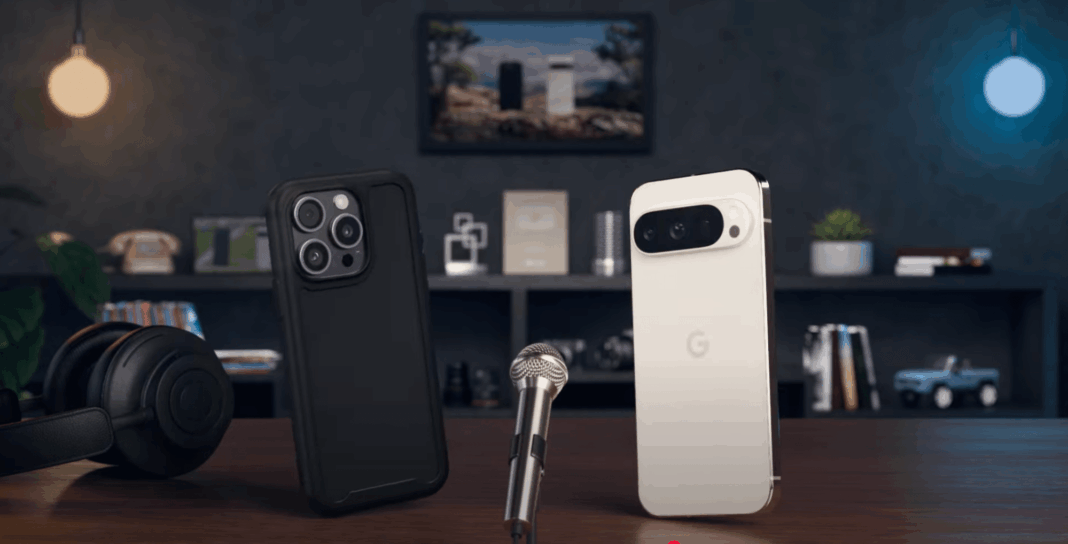The tech world is buzzing, and it’s not just about the latest iPhone specs. A playful rivalry has erupted, with Google taking aim at Apple’s rumored iPhone 17 design. Forget hushed whispers and leaks; this is a full-blown digital smackdown, playing out across social media and tech forums.

Google’s Animated Antics
The Tweet That Started It All

The online discourse surrounding the iPhone 17’s alleged design similarities to Google Pixel phones ignited with a series of tweets. While specific tweets may be difficult to pinpoint definitively as the “origin” due to the rapid spread of information online, a few key posts from tech enthusiasts and analysts sparked initial speculation and discussion. These tweets often juxtaposed leaked images of the purported iPhone 17 design with existing Pixel phone models, highlighting striking visual similarities in elements such as camera placement, overall shape, and display notch design.

The Video’s Message
Google capitalized on this growing online buzz by releasing a humorous animated video. The video features a conversation between an iPhone and a Pixel phone, with the Pixel playfully suggesting that the iPhone has adopted some of its design cues. Through witty dialogue and subtle jabs, Google subtly pokes fun at Apple’s alleged copying of Google’s innovations. Key lines in the video, such as “It’s crazy. Can you imagine me doing the same thing you did first years later?” and “Total coincidence,” drive home the message of Apple borrowing from Google’s playbook.

Intentional Humor or Calculated Marketing?
The question arises: is Google’s video genuinely lighthearted or a carefully orchestrated marketing strategy designed to generate publicity and subtly undermine Apple’s perceived originality? While Google has a history of using humor in its marketing campaigns, the timing and content of this video suggest a more strategic intent. By leveraging the ongoing discourse about the iPhone 17’s design, Google effectively positions itself as the innovator and Apple as the imitator. This narrative, even if presented with a playful tone, can subtly influence consumer perception and potentially impact purchase decisions.
Echoes of Design History
The debate surrounding design inspiration and imitation is a recurring theme in the tech industry. While companies often draw inspiration from existing technologies and aesthetics, the line between inspiration and outright copying can be blurry. Throughout history, there have been numerous instances where Apple has been accused of borrowing design elements from other companies, leading to legal battles and public scrutiny. Google’s playful jabs at Apple’s alleged design similarities to the Pixel line are therefore not entirely out of the ordinary. They tap into a pre-existing narrative about Apple’s design practices and add a layer of humor to an otherwise contentious issue.
Tracing the Alleged Inspirations
Google’s recent video poking fun at Apple’s iPhone 17 design rumors has sparked a heated debate about the origins of the iPhone’s design elements. Specifically, Google has pointed out several Pixel design features that are rumored to be influencing the iPhone 17. Let’s take a closer look at these similarities and differences.
The video highlights the Pixel’s clean and minimalist aesthetic, which has been a hallmark of Google’s design philosophy. One of the most notable similarities is the use of a camera bar on both devices. The iPhone 17’s rumored camera bar is similar to the Pixel 6 Pro’s camera bar, which features a horizontal arrangement of cameras. While the iPhone’s camera bar is slightly thicker and more angular, the overall design language is strikingly similar.
Another area of similarity is the use of a long, thin notch on both devices. The Pixel 6 Pro features a 2.3-inch notch, while the iPhone 17’s rumored notch is slightly larger at 2.5 inches. However, the overall shape and design of the notch are remarkably similar.
Google’s video also points out the use of widgets on both devices. The Pixel 6 Pro features a simple, icon-based widget system, while the iPhone 17’s rumored widgets are more complex and feature-rich. While the design language is different, the overall concept of providing users with quick access to information and controls is similar.
However, there are also some notable differences between the two devices. The Pixel 6 Pro features a 6.7-inch display, while the iPhone 17’s rumored display is slightly smaller at 6.5 inches. Additionally, the Pixel’s design language is generally more minimalist and clean, while the iPhone’s design is often described as more ornate and feature-rich.
In conclusion, while there are certainly similarities between the Pixel 6 Pro and the iPhone 17, there are also some notable differences. As the design world continues to evolve, it’s clear that both Google and Apple are pushing the boundaries of what’s possible with device design.
Visual Comparisons
The following images illustrate the similarities and differences between the Pixel 6 Pro and the iPhone 17.
Apple’s History of Inspiration
Apple has been accused of borrowing design elements from other companies in the past, and the current situation is no exception. Let’s take a look at some previous instances where Apple has been accused of copying design elements from other companies.
One of the most notable examples is the design of the original iPhone, which was heavily influenced by the Samsung Omnia. The Omnia’s design featured a large touchscreen, a stainless steel frame, and a minimalist aesthetic that was later adopted by Apple. While Apple’s design was certainly more polished and refined, the overall inspiration is clear.
Another example is the design of the iPad, which was heavily influenced by the Microsoft Surface. The Surface’s design featured a large touchscreen, a sleek and minimalist aesthetic, and a focus on portability and convenience. Apple’s iPad design was certainly more polished and refined, but the overall inspiration is clear.
More recently, Apple was accused of copying the design of the Google Pixel 3’s camera bar for the iPhone 11 Pro. While Apple’s design was certainly more polished and refined, the overall inspiration is clear.
In conclusion, Apple’s history of inspiration is complex and multifaceted. While the company has certainly made its own unique contributions to the world of device design, it’s also clear that Apple has borrowed design elements from other companies in the past.
The Blurred Lines of Innovation
The issue of design inspiration versus outright copying is complex and multifaceted. Where does the line get drawn, and what are the ethical considerations surrounding design borrowing in the tech industry?
One of the key issues is the concept of innovation versus iteration. Is it innovation to take an existing design element and refine it, or is it simply iteration? The answer is not clear-cut, and it’s often a matter of interpretation.
Another issue is the concept of cultural influence. Design elements can be influenced by cultural and societal trends, and it’s often difficult to determine where inspiration ends and copying begins.
Expert analysis suggests that the line between innovation and copying is often blurry and subjective. “Design is a process of iteration and refinement, and it’s often difficult to determine where innovation ends and copying begins,” says John Maeda, former president of the Rhode Island School of Design. “The key is to create something new and original, while also being respectful of the design language and conventions that came before.”
In conclusion, the issue of design inspiration versus outright copying is complex and multifaceted. While there are certainly lines to be drawn, the key is to create something new and original, while also being respectful of the design language and conventions that came before.
Conclusion
So, Google’s poking fun at Apple’s rumored iPhone 17 design, throwing shade at the seemingly insignificant tweak to the notch. It’s a playful jab, sure, but it speaks volumes about the competitive landscape of tech giants. Google’s audacity to publicly mock its rival highlights the cutthroat nature of the industry, where even the smallest design change becomes a battleground. It also underscores the increasing difficulty for companies to truly innovate, with even incremental advancements scrutinized and dissected by the public and competitors alike.
This isn’t just a silly social media spat; it’s a microcosm of the larger tech race. As innovation slows and differentiation becomes harder, we might see more of these public jabs and marketing skirmishes. The question is, how will consumers react? Will they be entertained by the antics, or will they grow tired of the constant one-upmanship? The answer will likely shape the future of this industry, determining whether the focus remains on genuine technological advancement or on outdoing the competition with clever marketing ploys.
Ultimately, the true winner in this game of tech-tussle isn’t necessarily the company with the flashiest design or the sharpest wit, but the one who delivers a product that truly resonates with users. In a world saturated with information and distractions, meaningful innovation will always cut through the noise.


